Although volleyball looks like a very simple sport it is actually quite complex and the first time you attempt to play it you may leave feeling very confused and maybe even slightly embarrassed.
I know for a fact that the first time I went to a training session I had no idea where I was going, what my role was or even what the core rules really were.
Well that is what this article is for.
I am hoping that this article will arm you with the tools you need to go to your first training session with confidence, so that you can leave feeling good about the session and ultimately help your progression as a player.
A discouraged player will always hold themselves back in the fear or embarrassing themselves which definitely does not help speed up the learning curve.
Table of Contents
Basic Volleyball Rules That You Should Know Before Your First Session
Now I don’t want to jump the gun and start reeling off rules before you have even set foot on the court.
However, without first knowing these basic rules the game of volleyball will make very little sense to you.
I am not going to go over specific rules and the faults and illegal moves.
More, just the core rules that make up the game of volleyball.
This way when you turn up and play a game you will already know how the sport is played.
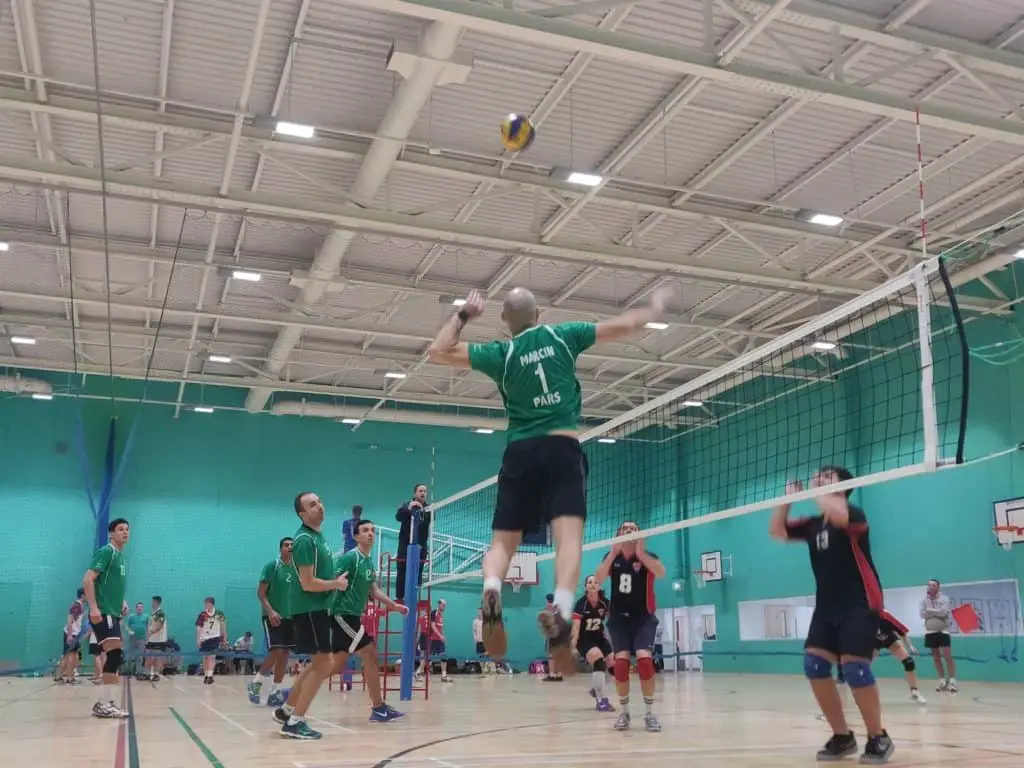
- There are 6 members per team on the court at anyone time.
- Each team is allowed 3 touches per side.
- One player can not touch the ball twice consecutively apart from when blocking (See blocking skill below).
- Every rally starts with a serve.
- The antennas fixed to the net mark the playing area. If the ball travels over or round the outside of the antenna it is out of bounds.
- The serve must be taken behind the baseline (Back line at each end of the court).
- Net touches are not allowed.
- The ball can contact the net at any point between the antennas and still be in play.
- If the ball contacts the net outside of the antenna including the support ropes and posts it is automatically out of bounds.
- Players must not fully cross the center line directly below the net.
- Every time a point is won the winning team will also win the next serve.
- Every time a team wins a point when they are the receiving team, every player must rotate 1 position to their left.
- Teams only rotate if they win the point from the serving team, not when they are the serving team.
- Official Volleyball matches are best of 5 sets. This means a team can win 3-0, 3-1 or 3-2.
- A set is played to 25 points however a team must win by 2 clear points to win the set, this means if the score is 24-24 a team would need to win 26-24 to take the set.
- There is a line 3m from the net on both sides of the court, this divides the back court players from the front court players.
- Back court players can not jump and hit the ball over above the height of the net inside the 3m line
Basic Volleyball Skills And When To Use Them
There are a few core skills that are required to play volleyball effectively.
These skills are used either to ensure no faults occur by performing illegal moves or alternatively they are the most effective and efficient way of playing.
Please try and use the correct techniques and movements as it will make your life and progression a whole lot quicker.
Serving

The serve is the first action of every single rally so it is extremely important to understand what it is and how it works.
Now I have a separate article on the different types of serves and how to perform them so I am not going to go into technique on this article.
I am simply going to offer the basics of what you need to know.
As stated the serve is the start of every single rally.
The server must stand behind the baseline when serving.
The baseline is the line at the very back of the court at both ends.
Once the referee has blown their whistle to signify the start of the rally, the server has 8 sections to throw the ball up and serve it over the net on to the opponent’s side.
The aim of the serve is to make the ball land on the opposition side in order to win a point.
Passing or Digging
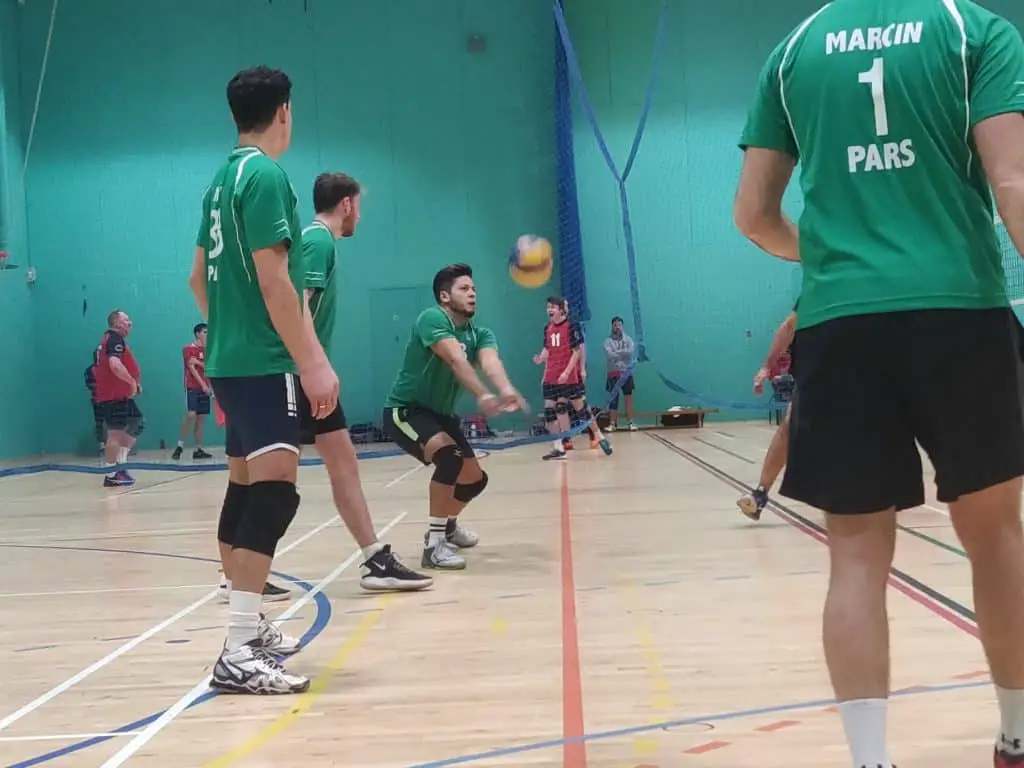
Passing and Digging are actually slightly different things however for the sake of learning the basics everyone will understand exactly what you mean regardless of which term you use.
To learn how to pass or dig read this article here.
Passing is the art of passing the ball to the setter or to a teammate.
Whereas digging generally refers to someone hitting the ball to prevent it hitting the floor from an opponent’s attacking hit.
Just so we are clear
- Passing is normally the action of getting the ball to the setter from say the oppositions serve
- Digging is preventing the ball from hitting the floor on your own side from the oppositions attack
This skill is generally the first contact of the ball on any side of the court.
With this in mind we want to try and remember that if we are the first person to touch the ball on our side we want to try and pass the ball to the setter.
Setting
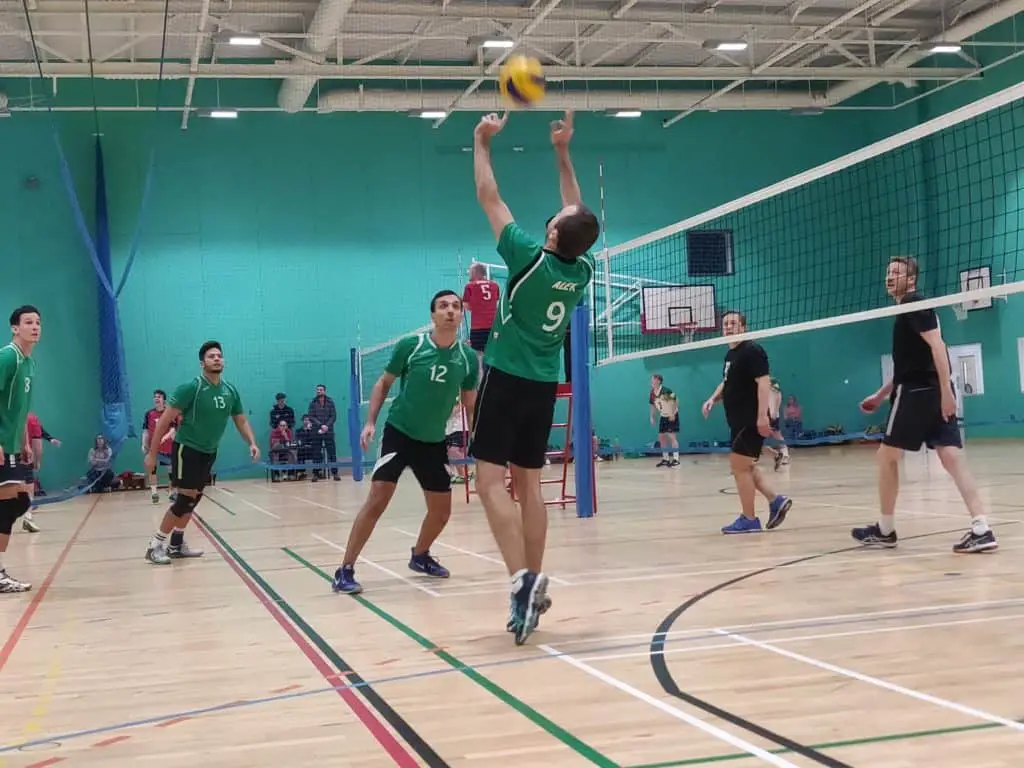
The set is generally the second contact the team will have on their side.
Once the ball has been passed to the setter, this person will put the ball up in the air (above the height of the net) and in a good region for their teammate to spike the ball.
Normally the setter will want to use an overhand set rather than a bump set to put the ball up in the air for their teammate.
To learn exactly how to set you can read this article here, in this article I also touch on exactly what an overhand set (volley) is and also what a bump set is.
Spiking
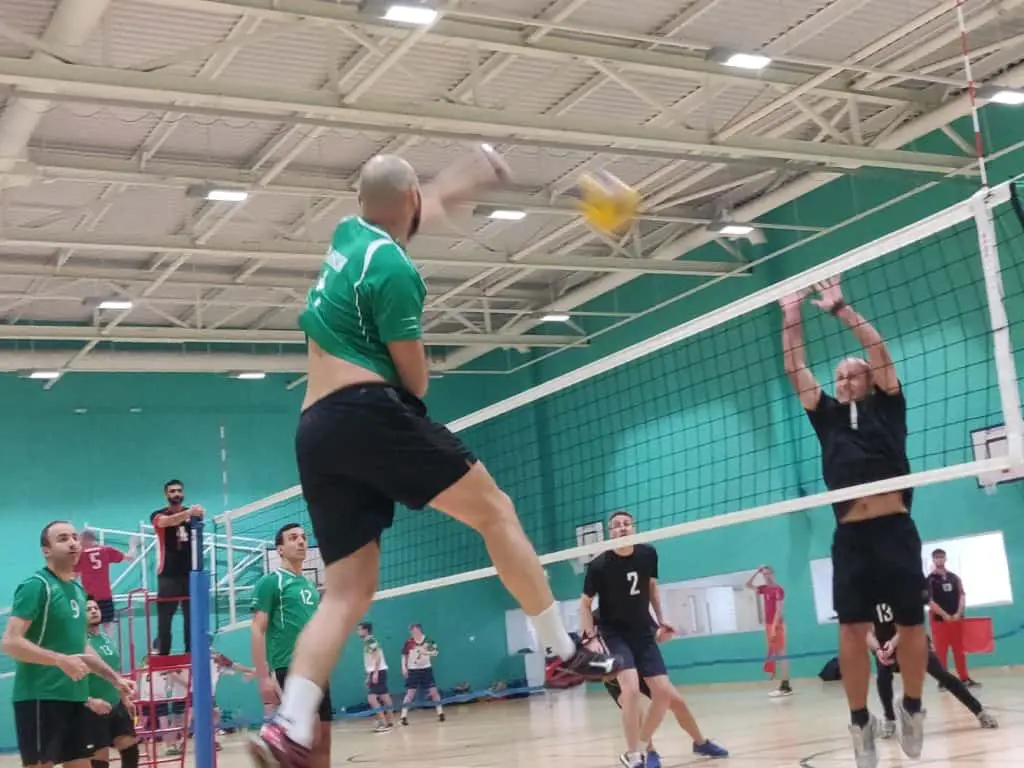
The spike also known as the hit is normally the third contact on one side from the team.
Spiking is where a player attacks the ball (hopefully from above the height of the net) with the aim of grounding the ball on the oppositions side or alternatively forcing the other team to make a mistake.
This should be the most powerful attack and you want to try and put the other team under pressure as this is the last contact you are allowed on any one side.
If you want to learn more about the spiking technique click here.
I also talk about some other shots that you can use if the set or your timing isn’t very good.
Blocking
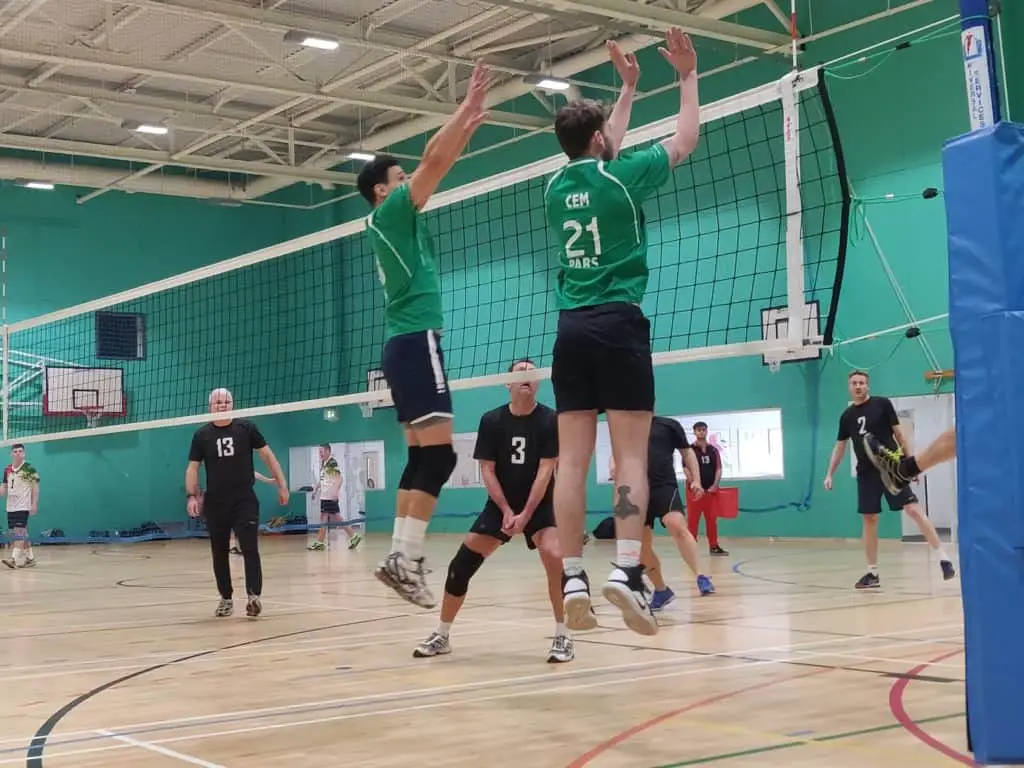
Now I will be honest is this is your first session going to volleyball I would say don’t either bother worrying about blocking.
But I understand that just because I don’t think you should confuse things and try blocking it doesn’t mean that other players won’t be blocking.
Due to this fact I want to ensure that you understand what a block is and what it means to your teams 3 touches.
The block is used to prevent the ball coming over the net onto your side from the opponent’s attack.
The players at the front net will attempt to jump above the height of the net and press the arms and hands over the net (without touching the net). The idea is to place your hands and arms in the path of the hitter so that when they hit the ball it hits your arms and or hands and goes back on your opponent’s side.
One thing that is very unique about blocking is that it doesn’t count towards your teams or even the individuals contacts.
This means if a player on your team blocks the ball but it still lands on your side anyone on your team including the player who blocked the ball can contact it again.
It also means that your team still has all 3 touches to pass, set and spike the ball back over the net.
Now like I said I wouldn’t worry too much about trying to block as it can become confusing, however it is important to remember that if your teammate blocks the ball but it still comes over the net on your side, you as a team still have 3 touches remaining.
What Are The Positions In Volleyball
It is worth noting that you aren’t likely to play specific positions during your early stages of volleyball.
Instead you will likely rotate one position when you win the point from the serving team and play the role of the position you are currently stood in.
In Volleyball there are a total of 6 playing positions.
Depending on where you are stood on the court will decide at which number position you are stood.
So you can visualize this I will put in an image below that shows which position is what number.

Now these numbers are much more important when it comes to rotating to play specific positions however, generally speaking the positions for each number are as follows.
If you are stood at position 1 you would normally be an opposite player
If you are stood at position 2 you would normally be the setter however some teams like to set from position 3, in which case you would play as the opposite.
If you are stood at position 3 you would normally be the middle hitter although as stated above some team like the setter to be in this position.
If you are stood at position 4 you would be the outside hitter
If you are stood at position 5 you would be the back court middle hitter or libero (Although in this case you would just play defense as a back court player)
If you are stood at position 6 you would an outside hitter.
Now I know they may sound a bit confusing but I will put what your role is at each spot below and hopefully it will make things a little clearer.
What Are The Roles Of Each Volleyball Position
So starting at position 1 as stated above this would often be the opposite player.
When playing position 1 as the opposite player you are primarily a defender.
Opposite Roles and Responsibilities Volleyball
It is your job to save the ball from hitting the floor from your opponent’s attack.
Now to make this job easier there are certain base positions which you should stand in when your opposition are attacking.
If they are hitting the ball from the side closest to you, your job is to stand on the sideline and pick up the ball that is going in or around that side of the court.
If the ball is being hit from the middle you will want to step forwards towards the net slightly and face the middle of the court to pick up the ball hit to your side.
Lastly if the ball is being hit from the opposite side to which you stand you want to again step forward and face the hitting direction to pick up any balls they hit cross court towards you.
The last role you have when playing at position 1 if you may need to attack the ball from the back court.
This means you must jump and leave the floor behind the 3m line and hit the ball over the net. This is sometimes known as a 10 attack.
So if you hear someone shout 10 make sure you are ready to spike the ball.
Setter Roles and Responsibilities Volleyball

At position 2 you would normally have the setter (or as stated previously the opposite).
When setting as a front court player your main job is to set up your teammates to allow them to spike the ball. Hence the name setter.
This means that generally you will take the second ball in the rally, so if you see your teammate get the ball up, remember it’s your turn next.
The other role that you will have as a front court setter is blocking.
Your main concern is the player hitting on your side however if you can help the person blocking middle i’m sure they would appreciate it.
As stated earlier I have already covered how and where to block in a different article so click the link if you want to know more.
Middle Roles and Responsibilities Volleyball
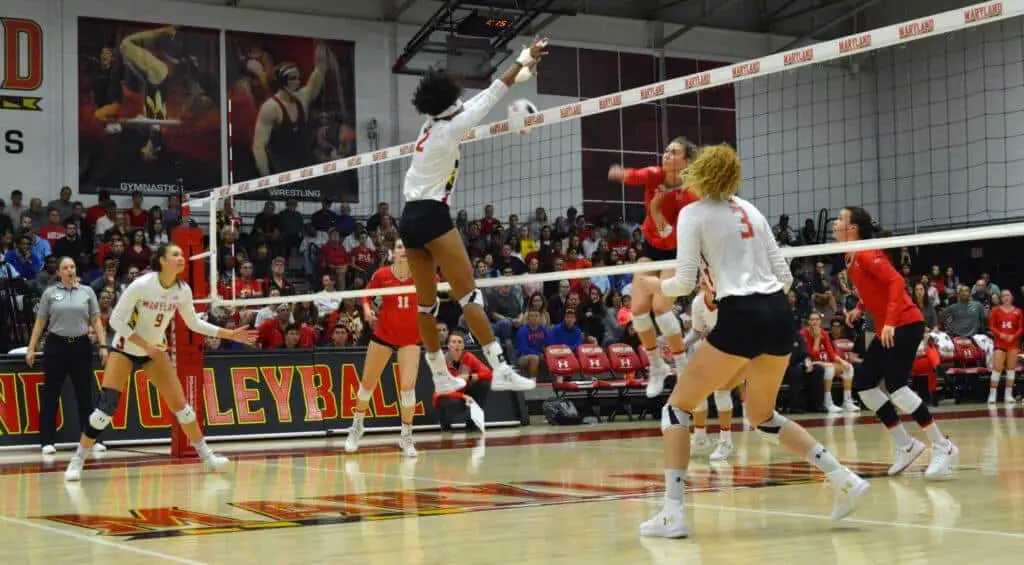
In the 3 position you will be a middle hitter sometimes referred to as the middle blocker.
Being a middle can be one of the hardest positions in volleyball.
At higher levels you are responsible for trying to block every attacker on the opposition and you also need to hit very quick difficult balls from the setter.
At a beginner level I would suggest you focus only on trying to block the middle on the other team and ask the setter to give you a bit more time with the set to make hitting the ball much easier.
Your only real jobs as a middle player is block or spike.
Outside Hitter Roles and Responsibilities Volleyball
In position 4 you will be an outside hitter.
The outside hitter has quite a large number of responsibilities. In the front row you main roles will be to block the player hitting through your side and attack the ball from the setter.
Much like with the setter if you can help the middle blocker they will always appreciate it however just focus on your match up.
Unlike the middle the outside hitter does have defensive duties as well.
If the ball is being hit from the other side of the court from where you are playing you should help on defense.
To do this step back off the net towards the 3m line and also step inwards towards the center of the court slightly.
When defending from this position you will be responsible for getting the ball up if they hit along the net towards your line.
You will also be responsible for getting the roll shots or tips that are put just over the block towards your position.
Libero or Back court Middle Roles and Responsibilities Volleyball
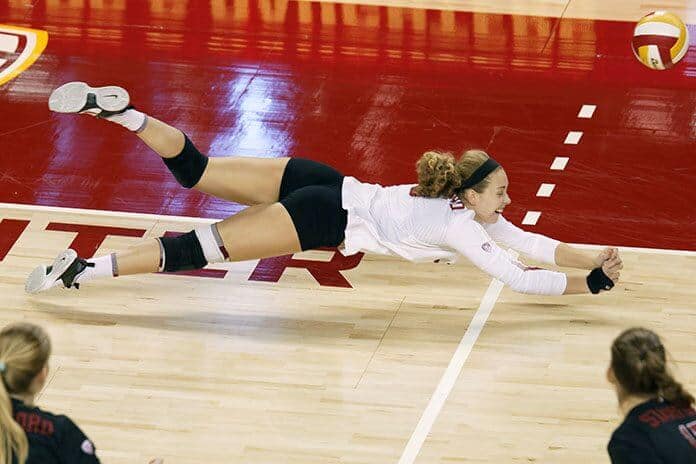
In position 5 you will either play as the Libero or the Middle when back court.
Realistically they serve the same purpose at this position and that is to prevent the ball from hitting the floor.
Much like the opposite player at position 1 there are certain base positions to make this easier.
The base positions will be exactly the same as the opposite player only flipped to suit the opposite side.
Now some of you may be reading this and wondering what exactly a Libero is?
Well a Libero is a player who only plays back court, hence the term ‘Defensive Specialist’.
As you now know, every time a point is won off the serving team you must rotate 1 position.
Due to this the Libero is subbed in and out of the game.
As the middle players don’t often pass very much they are normally the weakest passers in the team (due to lack of practice) as such when the middle player reaches the backcourt, they will often serve and then be subbed out of the game to allow a better passer to take their place.
In the early stages you won’t need to worry about the Libero position so don’t be afraid to hit the ball back court if it comes your way.
The Back Court Outside Hitter Roles and Responsibilities Volleyball
The player at the 6 position would traditionally be the outside hitter however in the early stages you only really only need to be concerned about your back court duties.
The duties of an outside hitter in the back row is mainly defending much like the libero or opposite in the back row.
The main difference between the outside hitter in the back row and the other players is the base positions and what area of the court you should generally cover.
The 6 player is normally the deepest player on the court, this means their job is to save any balls that might hit the floor near or on the back line.
If the opposition is hitting from the left side you will want to take a step around to your left so that you are not hiding behind the blocker and also you are standing in the oppositions power line.
If the opposition are hitting from the middle, if your team and coordinated and you know which side they the middle will block for you, your best bet is to take a step backwards and get ready to react to any balls that get hit deep or come off the blockers hands.
If the opposition is hitting from the right side you will also want to step around to the right so you can see the ball past your teammates block, whilst staying further back than the rest of your team to get the deep balls.
Alternatively if the opposition is hitting from the left you would also step around to your left and again stay further back.
The last role an outside hitter has when playing back court is attacking.
Sometimes when the setter is struggling they may set the ball up for the player in the middle of the back court.
This is known as a pipe attack.
Again remember you are back court so you must jump before the 3m line when hitting a pipe attack.
What To Expect From Your First Beginner Training Session
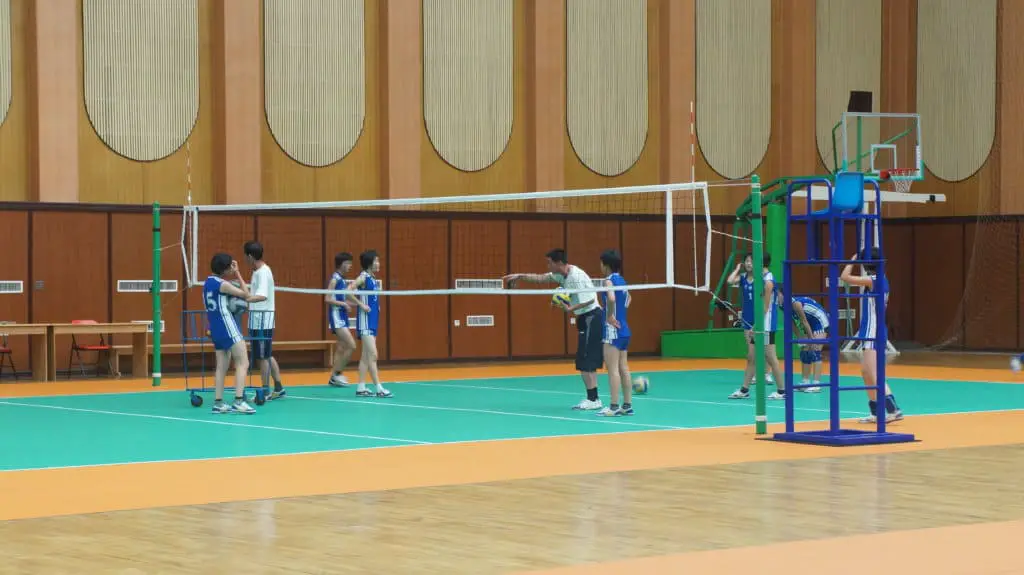
Know you have an understanding of the rules, skills and what you role will be when standing in certain positions, I want to cover what you might expect to do in your first beginner training session.
The reason I want to touch on this is because I know some people are scared of the unknown and this might prevent you from wanting to go to a training session.
When you first arrive depending on how organised the session is, you may warm up as a group or you may be left to get yourself warm.
Either way a traditional warm up would include a couple of laps of the court to get the blood flowing before doing some dynamic stretches.
Once everybody has got their body warm for exercise it is time to get body ready for volleyball.
Normally you would pair up with someone and go through a series of volleyball related actions to get the body prepared.
Just to give you an idea of what I would tend to do I will put a little list below:
- 2 hand high throw (like a soccer player throwing the ball back in from the sideline)
- 1 hand high throw
- Swing side throw (this is where you hold the ball in one arm and take your arm straight and backwards to your side, using your arm like a catapult, rotate your body and throw the ball to your partner)
- 2 Hand Bounce Throw (Using that soccer player technique, keep hold of the ball for longer and throw the ball forwards and into the ground with power)
- 1 Hand Bounce Throw
- Controlled spike motion (the idea is not to hit as hard as you can, simply practice the technique to ready your shoulders)
- More Powerful Spike Motion
- Pepper – Pepper is the term used when two players keep the ball up when warming up. It normally consists of the first player passing the ball up, the second player setting and then the third playing spiking the ball, the player that just set will attempt to pass the ball up so the drill continues back and forth.
After peppering for a sufficient time the training can officially start.
Now again I don’t know how organised of what level coach you will likely have so I can only offer my best guess at this point.
With that being said I would imagine the next phase of the training would be skill based drills, these might include passing drills, setting drills, serving drills or maybe spiking drills.
For the most part when I have coached beginners I have primarily worked on passing and control, if players feel confident passing then most players should be able to bump set a ball using a similar technique.
If you want to learn about what drills to expect you can look through some of my other articles about drills here
Once the skill based drills are out the way, it is time to put into practice what you just covered with game play.
This is where everything I talked about earlier will come into play as most coaches won’t be able to monitor all players at the same time and it may lead to confusion regarding court position etc..
Just remember what I talked about above regarding the rules and what your role is when stood in certain positions and you should be fine.
Helpful Tips To Make You More Confident In Your First Session
I have been at all levels of training throughout my playing career. I been to beginner training sessions when I first started, I then moved up to more intermediate training before eventually training with the top flight team in the highest league my country offers.
Throughout that journey I have had various spells of coaching my local team that play in a friendly league every week.
Having been on all sides of the coin there are a few things which will hopefully make you feel more confident in your first session.
- We all started from the bottom – Nobody and I mean nobody has turned up to a beginner training session and been perfect at everything. Volleyball unlike other sports is a game of technique as much as it about physical attributes.
- Don’t be afraid to ask questions if you are unsure on drills or positioning, everybody would rather hear the drill again then have you mess it up the first few times because you don’t understand, keeping the drill going when it has started is much more important that starting the drill later than planned.
- Don’t leave the ball for someone else. This is probably one of the most common issues I see in beginners who have just started training. In volleyball it is far more important that more than one person tries to play the ball than everyone leaving it out of confusion. Having read the above you know what your role is and when you should or shouldn’t take the ball, so be confident and go and get it. If you still have doubts someone is going to collide with you, give a big shout and say your name so everyone around you knows you are going for that ball.
So there you have it.
Everything you should need to know before starting your volleyball journey.
Above all us, Volleyball is about having fun doing an activity you love or think you will love, so with that being said.
Get out there and enjoy yourself.
